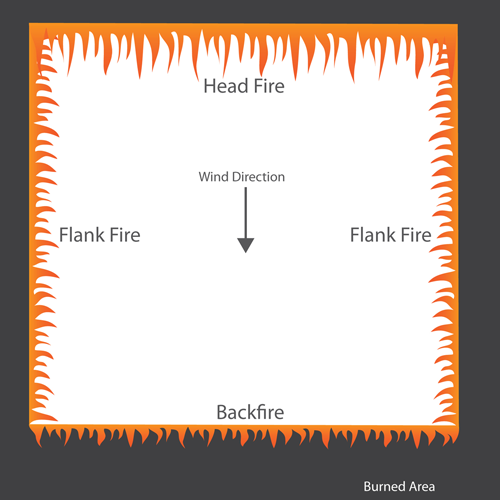There are many different techniques that can be used when lighting prescribed fires. The types of fire produced depend upon ignition technique and direction of the wind. These different types of fire are used in different areas of the burn depending on the conditions and objectives. The different types of fire include backfire, flank fire and head fire.

This image depicts the parts of a fire.
Types of Fire
A backfire is when you light off of a fire line and the flames burn into (against) the wind. Backfires are frequently used to create a line of “black,” or burned fuel, on the downwind side of the burn unit prior to lighting the flank or head fire. Backfires burn slowly and typically have short flame lengths.
A flank fire is a fire that burns perpendicular to the wind direction. Flank fires are commonly used after a backfire has been lit and let burn a safe distance, and prior to ignition of the head fire. Flank fires burn more quickly than backfires and the flames are greater in length.
A head fire is created when the fire burns with the wind, pushing the fire towards the un-burned fuel. Head fires are used when there has already been a backfire lit on the downwind side of the burn, and flank fires lit, or if you are burning towards an area such as a large body of water, or previously burned unit with no remaining fuel. Head fires move quickly and typically have longer flame lengths than the other types and can produce intense heat.
Ignition Techniques
A strip backfire is when you light multiple lines of backfires, usually just 5-15 yards apart. This is commonly used to speed up the process of putting in “black” or burned area prior to flank or head fires.
Strip flank fires are less common, because they can turn into a “running flank fire” if the wind direction changes, and can be dangerous for the burn crew. If this technique is used, the people igniting should be alert and aware of any wind shifts.
Ringing a burn unit, is when the perimeter of the entire burn unit is lit off at once. Ringing a burn unit is not as common as other ignition techniques, and is usually only done in a small burn unit. This is a very quick method of burning because the flames from each side of the burn unit feed off of each other and suck together, but if the wind switches it can easily cause an escape. This should only be done by very experienced burn bosses and crews.
The most common process of lighting a prescribed fire begins when the backfire is lit off of the downwind fire line. Once there is a safe amount of black, a person on each side of the unit will uniformely ignite the flank fires. When they reach the respective head fire area of the unit, they pause to monitor the amount of fuel that the back and flank fires have burned. When there is a sufficient amount of “black” or burned area, the two will wither ignite the headfire from both corners and meet in the middle, or one person will ignite the head fire.
Every burn plan and ignition type is different. Use what works best for the burn unit, crew and available equipment.
